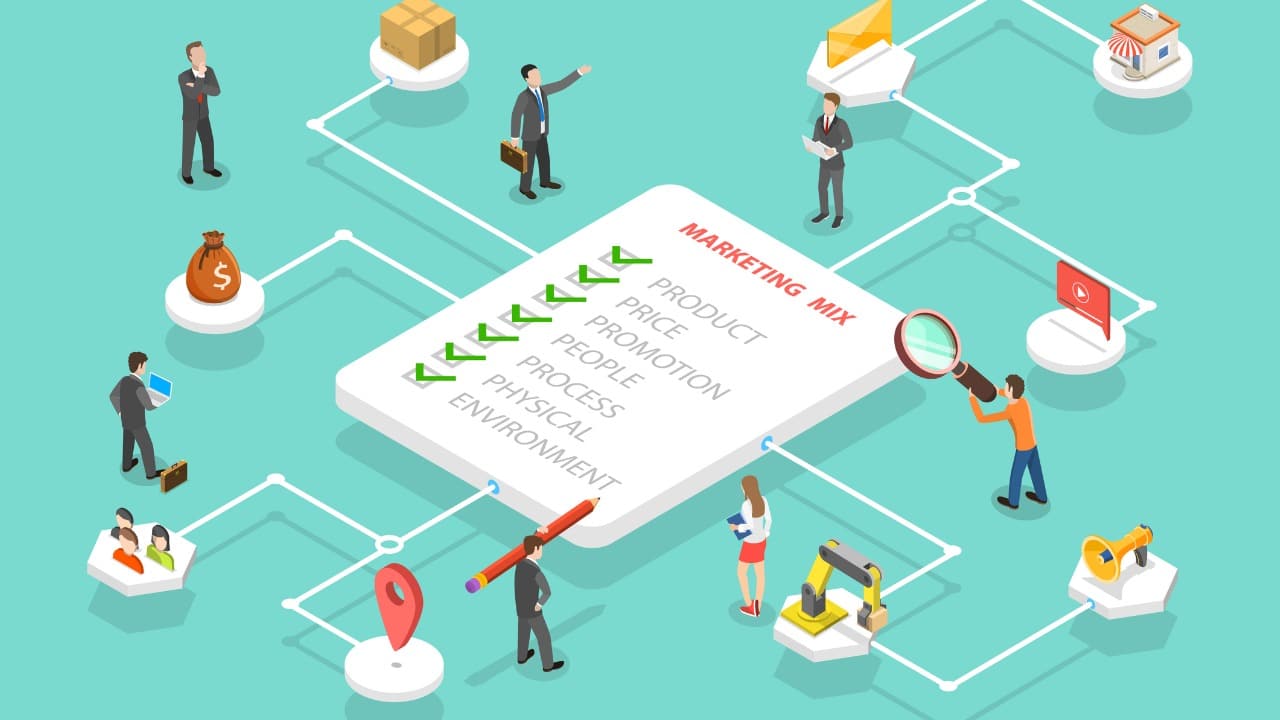The importance of digital marketing in today’s business landscape
In today’s highly competitive business environment, an effective digital marketing strategy is crucial to achieving success. As potential customers increasingly rely on the internet to research and purchase products or services, businesses must adapt and optimize their online presence to stay ahead of the curve.
The 7Ps of digital marketing provide a comprehensive framework for businesses to engage their target audience, build brand awareness, and ultimately drive sales. In this guide, we will explore each of the 7Ps – Product, Price, Place, Promotion, People, Process, and Physical Evidence – and provide actionable insights to help your business thrive in the digital landscape.
Product
Understanding Your Offerings
Developing a successful digital marketing strategy starts with a deep understanding of your products or services. Begin by creating a detailed profile of each offering, outlining its features, functionality, and unique selling points. This information will serve as a foundation for crafting targeted marketing messages that resonate with your audience.
Features vs. Benefits
While it’s essential to showcase your product’s features, emphasizing the benefits it provides to customers is even more critical. Benefits are the tangible outcomes or results that users can expect from using your product or service. Consider how your offering addresses customers’ needs, solves their problems, or enhances their lives. These benefits should be highlighted in all marketing communications to demonstrate the value your business delivers.
Product Differentiation
In the crowded digital marketplace, it’s crucial to establish what sets your product apart from competitors. To differentiate your offering, conduct a thorough analysis of your competition and identify areas where your product excels or offers something unique. This differentiation can be based on design, technology, customer service, or even your brand story. By emphasizing these distinctions, you can position your product as the preferred choice for potential customers and build a loyal following.
Price
Price Determination
Price plays a significant role in your customers’ decision-making process, and it’s essential to set the right price for your products or services. To determine the optimal price, consider factors such as production costs, competitor pricing, target market demographics, and the perceived value of your offering. Striking the right balance between these factors can ensure your price is both attractive to customers and profitable for your business.
Pricing Strategies
There are various pricing strategies available to maximize revenue and achieve your business objectives. Some common strategies include cost-plus pricing, where you add a profit margin to your production costs; value-based pricing, which focuses on the perceived value of your product; and competitive pricing, where you set prices in line with market rates. Evaluate the advantages and disadvantages of each strategy and select the one that best aligns with your business goals and target audience.
Discounts and Offers
Leveraging discounts, promotions, and special offers can be an effective way to attract new customers and incentivize repeat business. However, it’s crucial to implement these tactics carefully, as excessive discounting can devalue your product or service in the long run. Consider offering limited-time promotions, bundle deals, or loyalty programs to reward customers and encourage them to continue doing business with you. By strategically utilizing discounts and offers, you can boost your sales while maintaining your brand’s value and reputation.
Place
Choosing the Right Channels
In digital marketing, ‘place’ refers to the platforms and channels where you promote and distribute your products or services. With numerous options available, such as websites, social media platforms, email, and search engines, selecting the most effective channels for your business is crucial. To do this, analyze your target audience’s preferences and behaviors, and identify the platforms they frequent the most. By focusing your efforts on the right channels, you can optimize your reach and increase the chances of converting potential customers.
Localization
As you expand your digital presence, it’s essential to cater to the specific needs and preferences of different markets. Localization involves adapting your marketing strategy, content, and website design to meet the cultural, linguistic, and regulatory requirements of each target market. By creating a localized user experience, you can better connect with your audience and increase the likelihood of them engaging with your brand.
Optimizing Distribution
Maximizing the efficiency of your distribution channels is a critical aspect of digital marketing. To do this, continuously monitor and analyze the performance of each channel and identify areas for improvement. This could involve adjusting your content strategy, improving your website’s user experience, or investing in paid advertising to boost visibility. By refining your distribution strategy, you can ensure that your marketing efforts effectively reach and engage your target audience.
Promotion
Content Marketing
Content marketing involves creating and distributing valuable, relevant, and consistent content to attract and engage your target audience. This can include blog posts, articles, videos, infographics, and more. By offering high-quality content that addresses your audience’s needs and interests, you can position your brand as a trusted authority in your industry and foster long-term customer relationships.
Social Media
Social media platforms, such as Facebook, Instagram, Twitter, and LinkedIn, offer immense opportunities for businesses to expand their reach and connect with potential customers. Develop a social media strategy that aligns with your brand’s voice and goals, and consistently share engaging content to build a loyal following. Additionally, leverage social media advertising options to target specific demographics and further amplify your brand’s visibility.
Email Marketing
Email marketing remains a highly effective channel for nurturing leads and driving sales. By building a targeted email list and regularly sending relevant, personalized content, you can maintain strong relationships with your audience and encourage them to take action. Utilize marketing automation tools to streamline email campaigns and track performance metrics, allowing you to optimize your strategy over time.
Search Engine Optimization (SEO)
SEO is the practice of optimizing your website and content to rank higher in search engine results, increasing your online visibility and driving organic traffic. To improve your SEO, focus on aspects such as keyword research, on-page optimization, technical SEO, and link building. By continually monitoring and refining your SEO strategy, you can improve your search engine rankings and attract a larger share of your target audience.
People
Target Audience
Understanding your target audience is crucial to the success of your digital marketing strategy. To do this, create detailed buyer personas that represent your ideal customers, taking into account factors such as demographics, psychographics, and behavioral patterns. By knowing who you’re trying to reach and what motivates them, you can craft marketing messages and content that resonate with your audience and drive desired outcomes.
Personalization
Personalization is the practice of customizing your marketing efforts to cater to individual preferences and needs. By leveraging customer data and insights, you can tailor your content, offers, and promotions to deliver a more relevant and engaging experience for each user. Personalization can result in higher conversion rates, increased customer satisfaction, and stronger brand loyalty.
Customer Support
Providing exceptional customer support is a critical aspect of building and maintaining positive relationships with your audience. Ensure that your customers receive timely, helpful assistance through various channels, such as live chat, email, phone, or social media. By investing in customer support and addressing customer concerns proactively, you can enhance your brand’s reputation, foster loyalty, and encourage repeat business.
Process
Marketing Automation
Marketing automation involves leveraging technology to streamline marketing tasks and workflows, improving efficiency and reducing the potential for human error. By automating repetitive tasks, such as social media posting, email marketing, and lead nurturing, you can save time and resources while ensuring consistent and timely communication with your audience. Utilize marketing automation tools to enhance your digital marketing strategy and achieve better results with less manual effort.
Conversion Funnel Optimization
Conversion funnel optimization is the process of identifying and addressing bottlenecks or obstacles in the customer journey that may be preventing potential customers from converting. To optimize your conversion funnel, analyze each stage of the customer journey, and determine where visitors are dropping off. Implement strategies to improve user experience, such as simplifying navigation, optimizing landing pages, and offering personalized content, to increase the likelihood of conversion and maximize your marketing ROI.
Data Analysis
Measuring the performance of your digital marketing efforts is essential for making informed, data-driven decisions. Collect and analyze data from various channels, such as website analytics, social media insights, and email marketing metrics, to evaluate the effectiveness of your campaigns and identify areas for improvement. By continuously monitoring and adjusting your strategy based on data, you can optimize your marketing efforts and achieve better results over time.
Physical Evidence
Website Design
Your website is often the first point of contact for potential customers and serves as a virtual representation of your business. A well-designed website can create a positive first impression, instill trust, and encourage users to explore your offerings further. Focus on creating an aesthetically pleasing, user-friendly, and mobile-responsive website that effectively communicates your brand values and showcases your products or services.
Online Reviews
Online reviews and testimonials can serve as powerful social proof, influencing potential customers’ perceptions of your brand and their purchase decisions. Encourage satisfied customers to share their positive experiences on review platforms, such as Google My Business, Yelp, or social media. Respond to both positive and negative reviews in a professional and timely manner to demonstrate your commitment to customer satisfaction and continuous improvement.
Case Studies
Case studies provide tangible evidence of your product or service’s effectiveness by showcasing real-life examples of how your business has helped customers achieve their goals. Develop case studies that highlight your customers’ challenges, the solutions you provided, and the results they achieved. By sharing these success stories, you can build credibility, demonstrate your expertise, and inspire confidence in your offerings among potential customers.
In conclusion
The 7Ps of digital marketing – Product, Price, Place, Promotion, People, Process, and Physical Evidence – provide a comprehensive framework for businesses to create and execute effective digital marketing strategies. By understanding and implementing these principles, you can enhance your online presence, attract your target audience, and drive business growth.
For those seeking expert assistance in navigating the complexities of digital marketing, Seattle Digital Marketing offers a wide range of services tailored to meet the unique needs of your business. Partner with Seattle Digital Marketing to unlock the full potential of your digital marketing efforts and elevate your brand to new heights.


